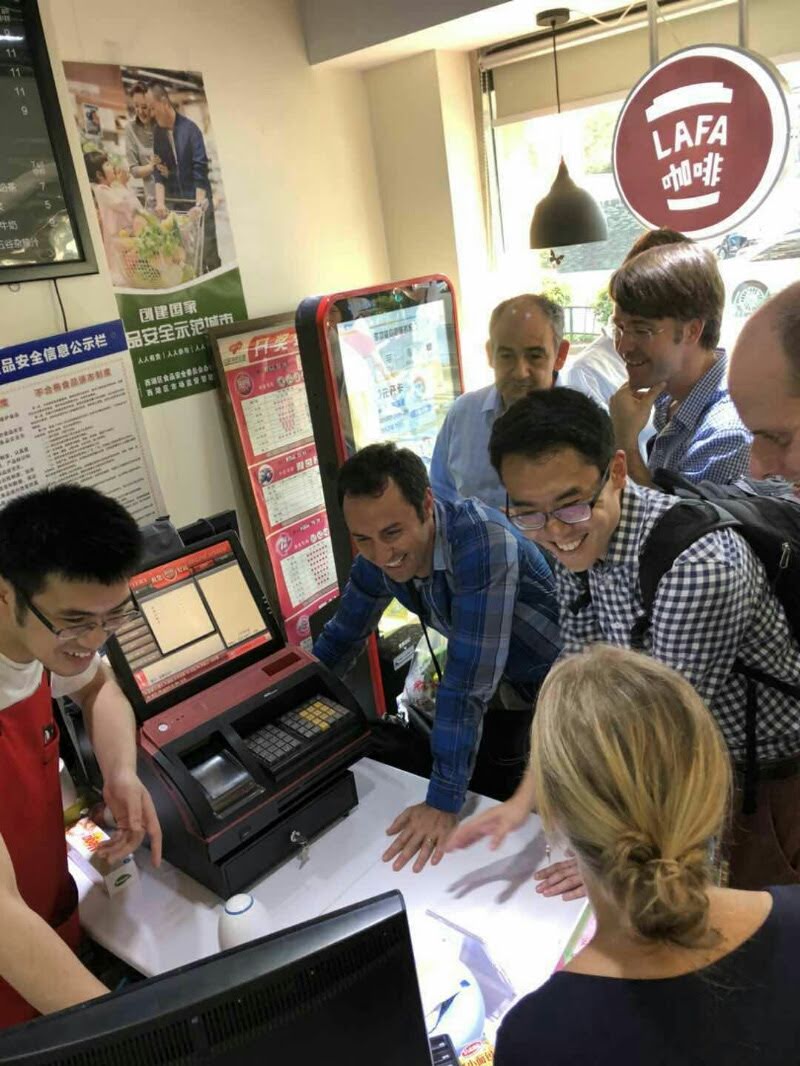In May, the FiDA Partnership took 26 leaders from Africa’s digital finance industry to China to learn about their unprecedented FinTech boom. The week was immersive and intense, designed to allow participants to escape the boardroom and experience Chinese digital life firsthand on the streets of Beijing, in the mom-and-pop stores of Hangzhou, and the on factory floors of Guangdong. In this blog, we reflect on the key lessons.

1. Government played a critical role in providing an enabling environment
There is no doubt that China’s protectionist policies allowed local players to flourish, free from competition from global incumbents. The government also invested considerably in establishing the ecosystem to support digital financial services. They mandated state-owned banks to provide widespread access, resulting in 80% of adults having a bank account and rural branch and ATM penetration on par with high income countries. This eliminates the need for FinTechs to develop expensive cash-in-cash-out networks as they have been required to do in sub-Saharan Africa. This has been underpinned by prioritization of rural development, providing broadband connectivity, universal IDs, and road infrastructure which lowers the cost of servicing remote areas.
Regulators’ “wait and see” approach sparked the FinTech boom in China. They began with an incredibly open framework, allowing models to evolve before tightening regulation, reminiscent of the approach that enabled MPesa to take off in Kenya. When regulation was eventually introduced it created space for FinTechs to flourish – over 200 licenses were recently granted to non-bank institutions. Companies we spoke to said regulators encourage frequent interaction with them. This means FinTechs know about upcoming rule changes and regulators are up-to-speed with new innovations, which is also assisted by regulatory sandboxes.
2. Business model innovation is happening in a big way
Laissez-faire regulation and growing tech expertise gave rise to innovative new players entering the financial services space with fresh business models. One such model is peer-to-peer (P2P) lending. This fulfils a demand from middle income savers seeking higher returns and greater flexibility than was offered by banks, and provides credit to the mass-market which was neglected by traditional financial institutions in favor of state-owned big business. We met China’s largest P2P lender, Yirendai, which offers prime borrowers access to unsecured credit by connecting them to investors through its online marketplace.
Digital finance business models in China are increasingly data-driven. Therefore, companies with large data pools and expertise in deriving insights from them have led the way. These tend to be tech giants such as JD.com, Alibaba and Tencent, so we are seeing profits in the financial services value chain shift from financial institutions to tech companies. The fact that these companies’ core business is not finance, but social networking or e-commerce, means they are not dependent on financial services revenues for their existence. This promotes experimentation and therefore product sophistication as companies can be patient for profit. It also means companies can subsidize entry-level products – usually payments – to encourage uptake. Alibaba’s rural e-commerce entity, Cuntao, explained how diversified revenues also help increase financial services’ reach: although bank business models lack incentives to serve rural customers who are low value and expensive to acquire and service, these clients hold value for e-commerce business models, permitting the financial services which support them to reach these communities as well.

3. The power of AI
China’s FinTechs have developed enviable know-how in artificial intelligence (AI), which has a visible presence in China: we shopped at JD’s unmanned stores which use smart shelves and facial recognition. We also saw AI in action at Weijun Grocery, a mom-and-pop shop in Hangzhou which uses Alibaba’s retail management platform to digitize inventory management. Weijun receives advice from the platform on what to stock based on historical sales, a trove of data about neighbouring communities, and timely information such as weather forecasts – for example to ensure ice-creams are in stock during a heatwave. We saw how cameras track customer movements to create a heat map showing where they spend most time in-store to help the owner optimise layout and merchandising.
AI is also used extensively on the back end. JD, Yirendai and Bairong told us how they leverage AI to process large datasets for risk management. JD uses more than 30,000 variables and 100 models to credit score over 200M users. Some of the variables used are astoundingly nuanced such as how hard a customer presses the screen and at what angle when they make a purchase. Their system is over 10x more efficient than traditional models and enables them to offer differentiated pricing. AI is also used to increase efficiency and efficacy of customer acquisition: Yirendai’s robo-adviser, Yiri, has resulted in a 50% hike in assets under management. WeBank, China’s first online-only bank, showed us their impressive live dashboard – like a banking version of NASA’s mission control! By using AI and blockchain they cut annual per user IT cost to $1 – a tenth of the industry average.

4. Partnerships are key
In the world of African digital finance, commercial partnerships are most eagerly sought by smaller companies hoping to leverage assets of larger incumbents – typically banks and MNOs. When collaborations do happen they are often tense, the imbalance of power played out in battles for revenue share and responsiveness. Rarely do we see strategic partnerships between giants, except out of regulatory necessity.
Not so in China. There, even the largest tech titans acknowledge that they can’t do it all. We heard about partnerships addressing a range of needs including risk management, scale, capital constraints, technology, expertise, and regulatory compliance. Two of the biggest players, JD Finance and Tencent, told us how they partner to share user data, enabling JD Finance to develop a deeper understanding of their customers for credit profiling. JD Finance explained how they partner with banks to access low-cost loanable funds in exchange for their large de-risked customer base. Yirendai revealed how they forward prospective clients to partners if they are unsuited to their own business model. In China, partnerships abound.
5. Social media & entertainment are powerful for customer acquisition
Tencent’s core business is social networking and entertainment, channeled largely through it’s messaging app, WeChat. WeChat offers a vast array of services – in Beijing we ordered taxis, hired Ofo bikes, ordered meals, checked movie times, and shopped online – all within the app. This grants WeChat relevance in almost all aspects of millions of users’ everyday lives, enabling Tencent to integrate financial services in meaningful ways with immediately applicable use cases. By designing experiences around lifestyles, financial transactions are minimized into the background of services that matter more to users. This is in contrast to what we see even in more mature digital finance markets in Africa where financial services are often offered in isolation from existing behaviors, limiting uptake and breadth of use.

6. Trust is a big pull factor
Professor Long Chen, Alibaba’s Chief Strategy Officer who joined us for a lakeside chat in Hangzhou, noted that tech platforms’ ability to create trust has been a significant growth factor. Micro-entrepreneurs in Panjiayuan Market, Beijing told us how digital payments took off because they eliminated the risk of fake notes. A Calligraphy Brush Seller noted: “I even use Taobao to sell to customers I already know because it creates trust. Payment only happens if the customer is happy & there is a process for returning goods if they are not”.

7. Rural e-commerce is creating new opportunities for job creation
Cuntao has extended e-commerce into rural areas by setting up 30,000 service centers at village convenience stores, enabling villagers with poor internet access to access goods previously unavailable to them. Centers receive goods ordered through Alibaba’s ecommerce sites and handle last mile logistics to customers’ homes, in return for commission. They are also education centers, teaching villagers how to shop online and helping them place orders.
Cuntao also provides two-way distribution infrastructure, enabling rural producers to access new markets. Clusters of rural online entrepreneurs who have spontaneously opened shops on Taobao Marketplace to sell their produce have emerged and have been termed Taobao villages, We went to one of them – Huidong – where we visited a factory started 6 years ago by a young man who worked in shoe factories his whole life, first as a labourer then working his way up to manager, designer, partner and finally starting his own business. He started the factory with $1,600 and a single room. He now employs 200 people and sells 1 million pairs of shoes annually on Alibaba platforms. It was impressive to see the role that e-commerce has played in creating jobs. Cuntao, told us their rural ecommerce solution has created more than 1.3 million new jobs nationwide and brings brings RMB 180,000 benefit annually to each village.

Olga Morawczynski from the Mastercard Foundation commented:
Tracking the economy of jobs that have been created because of Alibaba has been fascinating. Everything from people sorting the shoes to manufacturing the shoes to sorting the post-production material. We hear the story that technology destroys jobs but I think here we’ve seen the ability for it to create jobs and increase the rate of creation of jobs.
8. The future is offline
Alibaba believes that a foothold in traditional retail is the path to growth and has developed an online-to-offline (O2O) plan called “new retail”, which redefines commerce by enabling seamless engagement between online and offline worlds. New retail melds the best of in-shop and online experiences in new and unexpected ways, Using data such as purchasing history and store visiting habits, Alibaba intends to personalize product offerings, purchasing experiences and marketing campaigns. Alibaba’s Hema supermarkets incubate these innovations; we experienced how shopping there is a smartphone powered experience. We scanned QR codes to get product information and payment is cashless and almost touchless, using facial recognition combined with Alipay embedded in the Hema app. Each store also serves as a fulfillment center for online sales, delivering customer orders within 30 minutes to anywhere within a 3km radius.
This is all part of an effort to tap into the huge offline commerce sector in the world’s largest retail market. Despite the success of e-commerce in China, 85% of purchases still happen at brick-and-mortar stores, amounting to a $3.9trn opportunity. Venturing offline also enables Alibaba to access customers who are excluded from it’s online offerings owing to lack of digital literacy or phone ownership. Using offline experiences to bring people’s transactions online presents clear learnings for Africa.

